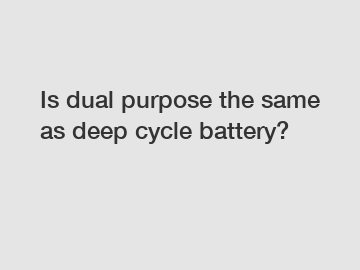Is dual purpose the same as deep cycle battery?
In the realm of energy storage, batteries play a crucial role. Whether it's for marine applications, recreational vehicles, or off-grid power systems, understanding the differences between battery types is vital. One common misconception often encountered is whether dual purpose batteries are synonymous with deep cycle batteries. In this comprehensive blog, we will unravel the different attributes of both battery types, shedding light on their unique characteristics and best-suited applications.
The Dual Purpose Battery:
Dual purpose batteries, as the name suggests, are designed to serve two primary functions: starting an engine and providing auxiliary power for onboard devices. These batteries excel in delivering high cranking power required to start an engine, making them a reliable choice for vehicles with moderate power demands. They inherently possess a combination of cranking and deep cycling capabilities, bridging the gap between cranking batteries and deep cycle batteries.

Deep Cycle Batteries:
On the other hand, deep cycle batteries are purpose-built to steadily provide power over an extended duration, making them well-suited for applications where consistent energy output is required. These batteries are specifically designed to tolerate frequent discharge cycles and subsequent recharge cycles without suffering performance degradation. Deep cycle batteries feature thicker lead plates with special alloys, allowing them to endure deeper discharges and prolonged use.
Important Distinctions:
1. Charging and Discharging: .
Dual purpose batteries are optimized for exceptional cranking power and, therefore, respond well to rapid charging and discharging. Deep cycle batteries, conversely, are designed to handle slow, controlled charge and discharge rates over a longer timeframe.
2. Capacity:
Dual purpose batteries generally have lower capacity compared to deep cycle batteries, focusing more on the ability to deliver short bursts of high power. Deep cycle batteries, with their enhanced capacity, provide a longer runtime and sustained power output.
3. Durability:
While both types of batteries are constructed for durability, deep cycle batteries exhibit better resilience to withstand the rigors of repeated deep discharge and recharge cycles. These batteries can withstand being discharged up to 80% without significant damage, whereas dual purpose batteries are better suited for shallower discharge cycles.
Ideal Applications:
Dual purpose batteries find their sweet spot in small boats, watercraft, and vehicles that require both engine starting power and auxiliary power for marine electronics and other accessories. Their ability to provide a quick burst of energy makes them reliable for these applications.
Deep cycle batteries, on the other hand, are ideal for long-duration applications where consistent power output is crucial. They are commonly used in renewable energy systems, recreational vehicles, golf carts, as well as marine applications that require prolonged battery use, such as sailboats or electric motor-powered vessels.
Conclusion:
In conclusion, while both dual purpose and deep cycle batteries serve specific purposes, they are not one and the same. Whereas dual purpose batteries excel in delivering cranking power alongside some deep cycling capabilities, deep cycle batteries prioritize long-term, consistent power delivery. Understanding these differences allows us to make informed decisions based on the specific requirements of our energy storage applications.
Whether you're in need of a battery for your boat, RV, or renewable energy system, knowing the nuances between dual purpose and deep cycle batteries can be invaluable. Remember, the right choice ultimately depends on the unique demands of your power needs. Empower yourself with this knowledge, and make an informed decision for your energy storage requirements.
Want more information on camel power, vda lithium iron phosphate battery, camel energy gmbh? Feel free to contact us.


